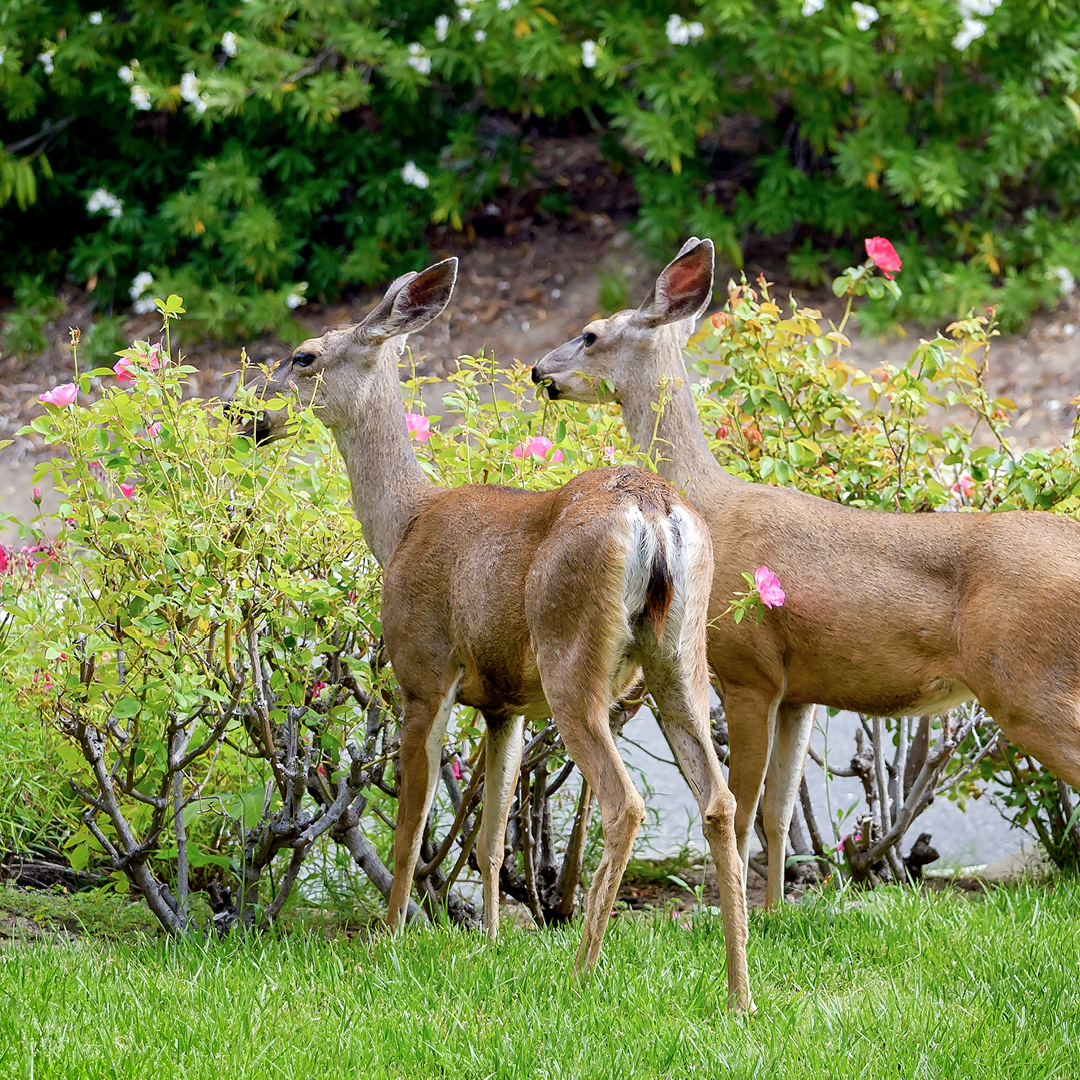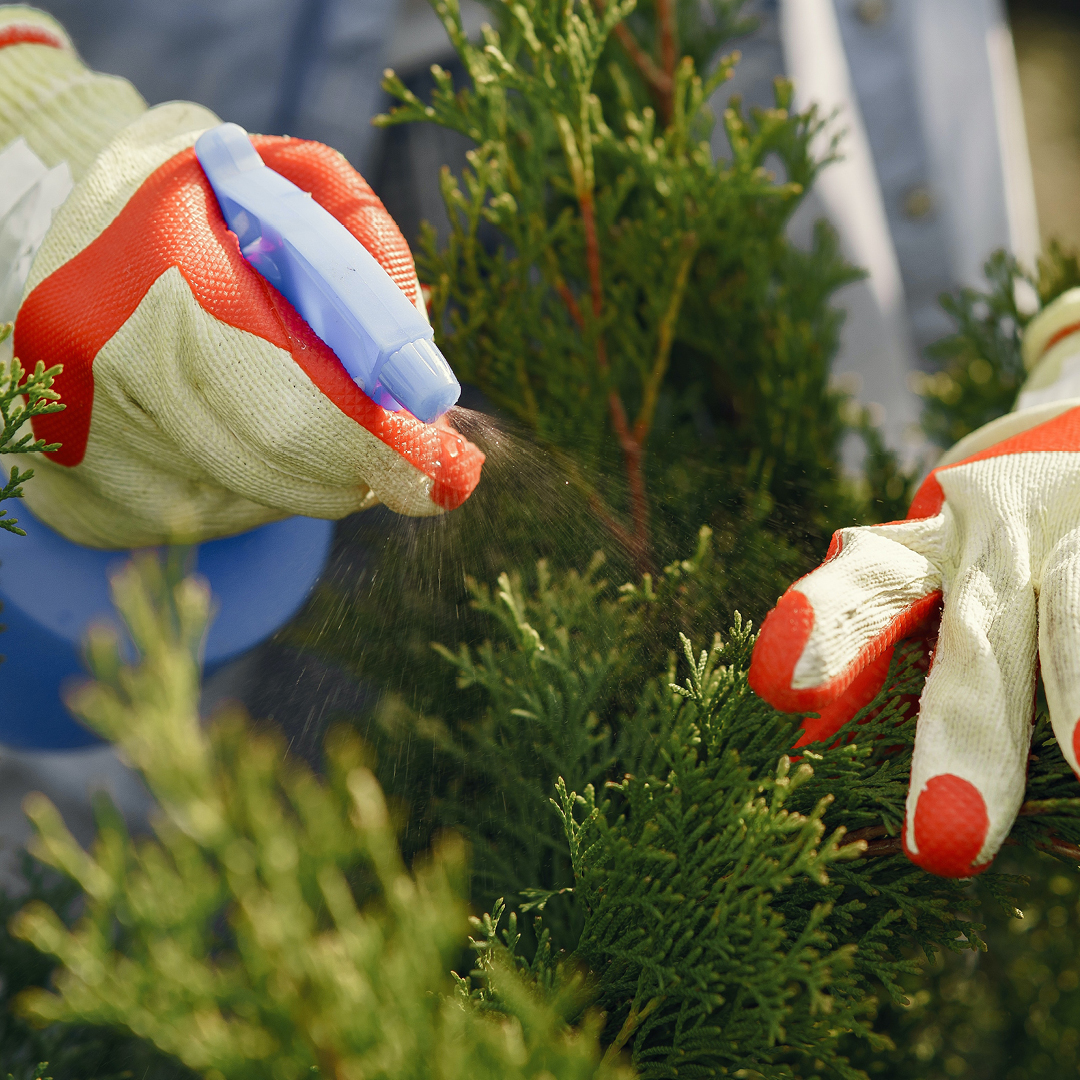For many homeowners, the sight of deer grazing in the yard is enough to make them sing the blues. While these creatures evoke a sense of natural beauty, their presence often spells trouble for homeowners and their landscapes. Deer browsing can decimate flower beds, vegetable gardens, and shrub borders, leaving gardeners frustrated and searching for solutions. We’re here to help you change your tune.
When Deer Are Most Detrimental
Deer are creatures of habit, and their feeding patterns are largely dictated by the seasons:
- Winter: Food is scarce in colder months, making evergreens, woody shrubs, and other plants a primary target. The lack of foliage in natural habitats pushes deer to browse in residential areas, often leading to extensive damage.
- Spring: New growth is highly appealing to deer. Emerging perennials, tender shoots, and budding trees provide a nutrient-rich buffet that can derail a garden before it even gets established.
- Summer: While natural food sources are more abundant, drought or habitat loss may drive deer into landscapes. Vegetable gardens and flowering annuals are particularly vulnerable.
- Fall: Deer begin to bulk up for winter and may feed heavily on fruit trees, shrubs, and other landscape plants. Male deer (bucks) also rub their antlers on young trees, causing physical damage.
Understanding these seasonal behaviors helps to tailor control strategies throughout the year.
Control Strategies
While no single solution works universally, combining multiple strategies offers the best chance of deterring deer.
Deer Fencing
Description:
Deer fencing is one of the most effective physical barriers. Proper fencing should be at least 8 feet tall since deer are excellent jumpers.
Types:
- Traditional Fencing:Made of wood, wire mesh, or plastic, installed around the perimeter.
- Electric Fencing:Gives a mild shock to deter deer. Often baited with attractants to ensure deer interact with it.
- Temporary Fencing:Lightweight netting for seasonal protection of specific plants.
Placement Tips:
- Install flush to the ground or bury the bottom a few inches to prevent deer from crawling underneath.
- Double fences (two fences 4-5 feet apart) confuse deer and are highly effective for larger properties.
Dogs
Description: Dogs can act as a natural deterrent by patrolling your property. Their scent and barking create a perceived threat that deer avoid.
How to Use:
- Allow the dog free rein in the yard or garden.
- Rotate where the dog spends time to cover different areas.
- Avoid tying dogs near sensitive plants, as deer may become accustomed to stationary threats.
Repellents
Description: Repellents discourage deer by targeting their sense of smell or taste.
Commercial Repellents:
- Odor-Based:Mimic the scent of predators or decay (e.g., blood meal, putrescent egg solids).
- Taste-Based:Use bitter or spicy compounds to make plants unappealing.
Homemade Repellents:
- Garlic Spray:Blend garlic with water and spray on plants.
- Egg and Milk Mixture:Mix eggs, milk, and water with a small amount of dish soap to create an unappealing coating.
- Hot Pepper Spray:Blend hot peppers with water and spray on foliage.
Application Tips:
- Reapply repellents every few weeks or after heavy rainfall.
- Alternate products or recipes to prevent deer from adapting.
Predator Urine
Description: Urine from predators such as coyotes or wolves mimics a threat in the area.
How to Use:
- Purchase commercial predator urine products.
- Apply around the perimeter of your property, reapplying every few weeks or after rain.
Considerations:
- May need frequent reapplication.
- Not suitable for very small properties due to the scent.
Motion Detectors
Description: Devices that startle deer with sudden noise, light, or water.
- Motion-Activated Lights:Floodlights that activate when deer approach, deterring them with brightness.
- Motion-Activated Sprinklers:Spray water when motion is detected, creating an immediate but harmless deterrent.
- Ultrasonic Devices:Emit high-frequency sounds to disturb deer.
Placement Tips:
- Place devices along deer pathways or near vulnerable plants.
- Regularly reposition devices to prevent deer from becoming accustomed to them.
Deer-Resistant Plants
Description: Some plants are naturally unappealing to deer due to their scent, texture, or toxicity.
Examples:
- Aromatic Plants:Lavender, rosemary, and sage.
- Prickly Foliage:Barberry, holly, and junipers.
- Toxic Plants:Daffodils, foxglove, and monkshood.
Companion Planting:
Plant deer-resistant varieties around more vulnerable plants to create a natural barrier.
Scare Tactics
Description: Scaring deer away uses sight, sound, or smell to create the illusion of danger.
Methods:
- Decoys:Owl or coyote statues placed in visible areas.
- Noise Makers:Wind chimes, aluminum pie pans, or other reflective, noisy objects.
- Scented Deterrents:Use soap bars or dryer sheets hung near plants to deter deer.
Tips for Success:
- Rotate scare devices frequently to keep them effective.
- Use in combination with other methods for best results.
Habitat Modification
Description: Modify your property to make it less inviting to deer.
Strategies:
- Remove dense shrubs or tall grass that provides cover.
- Avoid planting deer-favored species, such as hostas, tulips, and fruit trees, near edges or open areas.
- Reduce water features or accessible food sources that attract deer.
Plant Protection
Description: Protect individual plants or small areas with physical barriers.
Examples:
- Tree Guards:Wrap trunks with mesh or plastic to prevent browsing and rubbing.
- Netting:Cover shrubs or flower beds with lightweight netting to block access.
- Cages:Use wire cages around particularly vulnerable young plants.
Community Strategies
Description: Working with neighbors can improve deer deterrence in larger areas.
Examples:
- Pool resources for fencing large shared spaces.
- Coordinate planting strategies to reduce high-traffic areas for deer.
Key Takeaways
- Combine Methods: No single method is 100% effective; combining strategies works best.
- Persistence is Key: Deer are adaptable, so regular changes in tactics are essential.
- Seasonal Adjustments: Increase deterrence measures in late fall and winter when food is scarce.
Using a mix of these strategies tailored to your specific property, you can effectively minimize deer damage in your garden and landscape and sing a joyous tune.





 15% Military Discount
15% Military Discount